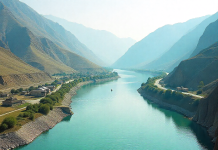Dr. Muhammad Akram Zaheer
The U.S.-Iran relationship has been marked by decades of tension, punctuated by moments of tentative engagement.President Trump’s administration introduced a distinctive approach, characterized by stringent economic sanctions coupled with overtures for direct negotiations.This strategy aimed to compel Iran to curtail its nuclear ambitions while opening avenues for diplomatic resolution. Central to Trump’s strategy was the reimplementation of the “maximum pressure” campaign, which involved reinstating and intensifying economic sanctions on Iran.These sanctions targeted vital sectors of the Iranian economy, aiming to cripple its financial capabilities and force compliance with U.S. demands regarding nuclear activities and regional behavior. In addition to economic measures, the Trump administration did not shy away from military actions.Notably, airstrikes were launched against Iranian-backed Houthi forces in Yemen, signaling a willingness to use force to counter Iran’s regional influence.Furthermore, President Trump set a tight two-month deadline for Iran to reach an agreement on its nuclear program, accompanied by explicit threats of military action should negotiations fail.
Contrasting the hardline economic and military stance, President Trump exhibited an inclination towards personal diplomacy.In early March, he sent a letter to Iranian Supreme Leader Ali Khamenei proposing negotiations, reflecting his belief in deal-making as a tool for conflict resolution.Trump’s assertion that he wanted to make Iran “prosperous again” underscored his approach of coupling pressure with the promise of economic relief and normalized relations. This dual strategy aimed to bring Iran to the negotiating table under duress while offering incentives for compliance.The administration’s hope was that the economic strain, combined with the threat of military action, would make the prospect of a deal more appealing to Iranian leadership.
While the strategy had its rationale, it was not without significant risks and criticisms.The aggressive posture raised concerns about the potential for miscalculations leading to open conflict.Military strikes on Iran’s nuclear facilities, while potentially delaying its nuclear program, could provoke retaliatory attacks across the region, exacerbating instability in the Middle East. Moreover, the economic sanctions, though aimed at the regime, had profound impacts on the Iranian populace, leading to humanitarian concerns.Critics argued that such measures could entrench anti-American sentiments and empower hardline factions within Iran, thereby undermining the prospects for diplomatic engagement.
The “Trump to Tehran” strategy highlighted the complexities of employing a dual approach in international diplomacy.By combining coercive measures with offers of negotiation, the administration sought to leverage pressure into tangible policy changes.However, the success of such a strategy depended on precise calibration and a deep understanding of the adversary’s thresholds and motivations. The strategy also had broader implications for U.S. foreign policy, signaling a shift towards more transactional and unilateral approaches.It challenged traditional diplomatic norms and raised questions about the efficacy and ethics of coupling punitive measures with overtures for peace. The evolving dynamics of U.S.-Iran relations have been marked by a complex interplay of confrontation and negotiation. In her article, “The Case for a ‘Trump to Tehran’ Strategy,” Comfort Ero explores the potential of combining President Donald Trump’s “maximum pressure” campaign with personal diplomacy to address the challenges posed by Iran’s nuclear ambitions and regional activities.
The Trump administration’s “maximum pressure” strategy involved re-imposing stringent economic sanctions on Iran after withdrawing from the Joint Comprehensive Plan of Action (JCPOA) in 2018.These sanctions aimed to curtail Iran’s nuclear program and diminish its regional influence.While the sanctions inflicted significant economic hardship on Iran, leading to a sharp depreciation of its currency and political instability, they also had unintended consequences.The economic strain bolstered hardline elements within Iran, fostering a narrative of resistance against foreign aggression and complicating internal reform efforts.Recognizing the limitations of unilateral pressure, President Trump initiated a direct diplomatic overture by sending a letter to Iranian Supreme Leader Ali Khamenei in early 2025, proposing negotiations.This move signaled a willingness to engage Iran through dialogue, offering the prospect of sanctions relief and normalized relations in exchange for concessions on its nuclear program and regional activities.The approach aimed to leverage Trump’s deal-making persona to achieve a breakthrough in the longstanding impasse.
Despite the overture, significant challenges persist.Iran’s leadership, particularly Supreme Leader Khamenei, remains skeptical of U.S. intentions, especially given the history of abrupt policy shifts, such as the withdrawal from the JCPOA.Internally, Iran’s political landscape is fraught with tensions between reformists and hardliners, making consensus on engaging with the U.S. difficult.Moreover, the U.S. domestic political environment, characterized by bipartisan skepticism toward Iran, limits the flexibility of the administration to offer concessions.The strategy’s reliance on the threat of military action as authority carries inherent risks.While targeted strikes, such as those against Iranian-backed Houthis in Yemen, may yield short-term tactical advantages, they risk provoking broader regional conflicts and undermining diplomatic efforts.A miscalculation could escalate into a full-scale confrontation, with devastating consequences for regional stability and global security.

















